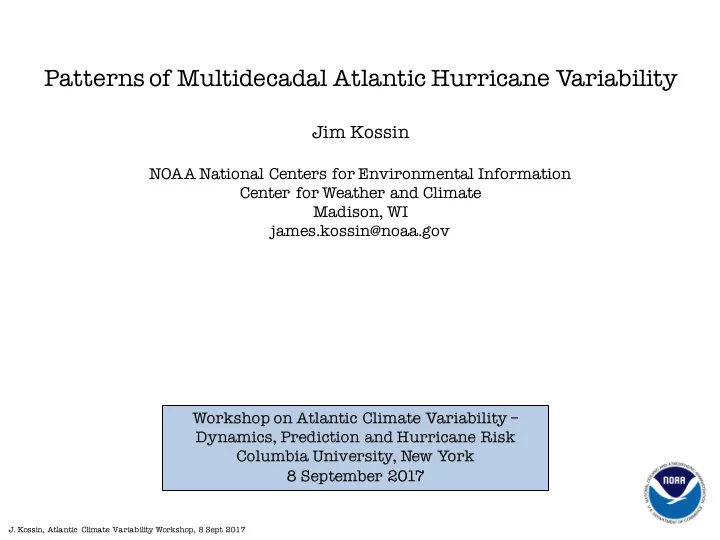

Patterns of Multidecadal Atlantic Hurricane Variability Jim Kossin NOAA National Centers for Environmental Information Center for Weather and Climate Madison, WI james.kossin@noaa.gov Workshop on Atlantic Climate Variability – Dynamics, Prediction and Hurricane Risk Columbia University, New York 8 September 2017 J. Kossin, Atlantic Climate Variability Workshop, 8 Sept 2017
The multidecadal variability of the tropical N. Atlantic ocean and atmosphere, particularly sea surface temperature and vertical wind shear, strongly modulates basin-wide Atlantic hurricane activity. SST Shear cool warm warm HU MH J. Kossin, Atlantic Climate Variability Workshop, 8 Sept 2017
There have been more than twice as many major hurricanes per year during the contemporary warm period compared to the last cool period These statistics reflect basin-wide activity and the environmental parameters are typically measured in the Main Development Region. Are there any regional patterns of variability that may be relevant but missing from these types of analyses? J. Kossin, Atlantic Climate Variability Workshop, 8 Sept 2017
Leading EOFs of SST and shear (VWS) Shear SST Kossin, J. P., 2017: Hurricane intensification along United States coast suppressed J. Kossin, Atlantic Climate Variability Workshop, 8 Sept 2017 during active hurricane periods. Nature , 541 , 390–393, doi:10.1038/natur e20783.
What effect do these regional patterns of multidecadal variability have on hurricanes? 6-hourly intensification rates near/along the U.S. coast HU MH Major hurricanes that approach or move along the U.S. coast are 3 to 6 times less likely to rapidly intensify during warm periods J. Kossin, Atlantic Climate Variability Workshop, 8 Sept 2017
Matthew J. Kossin, Atlantic Climate Variability Workshop, 8 Sept 2017
Regionally reduced shear during the last cool period allowed major hurricanes to survive at higher latitudes J. Kossin, Atlantic Climate Variability Workshop, 8 Sept 2017
Summary Atlantic multidecadal variability is best considered in terms of its pattern rather than via MDR averages. Important regional differences (sign changes) exist in the SST and shear co-variability, which causes large regional differences in how hurricanes are modulated by the multidecadal variability in the basin. An important unanswered question then is whether we can expect another cool phase, and if one emerges, how well will the previous cool period serve as an analog? J. Kossin, Atlantic Climate Variability Workshop, 8 Sept 2017
Recommend
More recommend